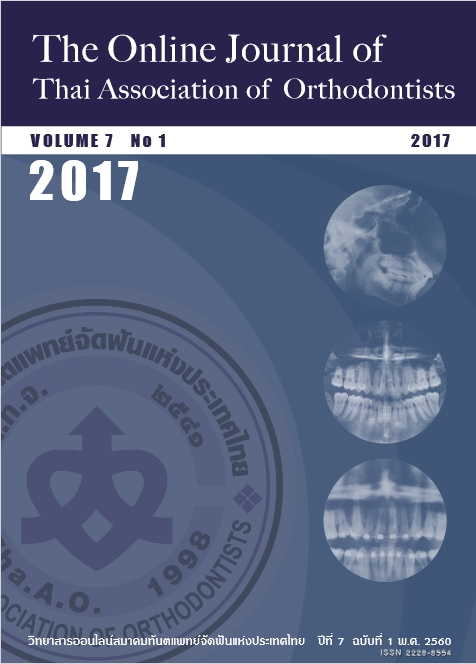Class III Elastic Traction: Classical and Modified Design
Main Article Content
Abstract
Class III elastic traction is an inter-maxillary traction from the lower canine region to the molar region of the upper arch. This moves upper teeth forward and lower teeth backward. Class IIIelastic traction is utilized in several situations such as, camouflage treatment in non-growing Class III patients, a maxillary orthopedic protraction in skeletal Class III patients with maxillary deficiency and an anchorage reinforcement. There are 2 types of Class III elastic traction’s design 1). Classical design and 2). Triangular Class III elastic traction, with or without upper lateral incisors engaged. This literature review presents various applications as follows 1). Class III elastic traction with accentuated curve of Spee archwires, 2). Class III elastic traction in multi-loop edgewise archwire appliance, 3). Class III elastic traction with headgear for lower arch retraction, 4). Class III elastic traction with temporary anchorage devices, and 5). Class III elastic traction with bone-anchoraged maxillary protraction. However, Class III elastic traction may result in undesirable side effects such as proclination of the maxillary incisors, retroclination of the mandibular incisors and upper molar extrusion. These side effects can cause the clockwise rotation of the mandible, which may result in many problems of dentofacial esthetics and stability, especially in the long face patients. To minimize these undesirable side effects, the modified design and several techniques such as transpalatal arch, Nance lingual arch, modified bracket system, modified arch wire, multi-loop edgewise archwire, extra-oral appliance, and temporary anchorage devices have been proposed to be used in combination with Class III elastic traction.
Article Details
How to Cite
1.
Benjakul S, Thongudomporn U. Class III Elastic Traction: Classical and Modified Design. Thai J Orthod [internet]. 2020 Sep. 14 [cited 2025 Dec. 24];7(1):20-8. available from: https://he01.tci-thaijo.org/index.php/THAIORTHO/article/view/249628
Section
Review Article

This work is licensed under a Creative Commons Attribution-NonCommercial-NoDerivatives 4.0 International License.


